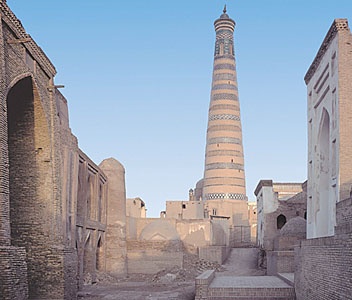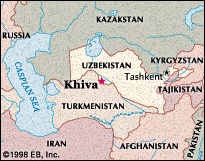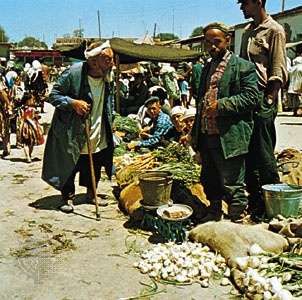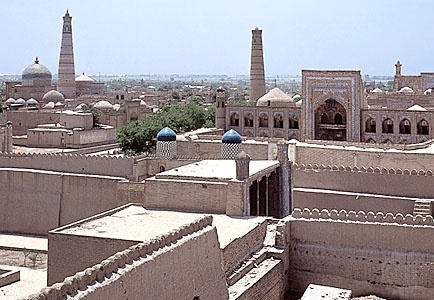Khiva
Uzbekistan
also spelled Chiwa, Chiva, or Jiva,


city, south-central Uzbekistan. It lies west of the Amu Darya (ancient Oxus River) on the Palvan Canal, and it is bounded on the south by the Karakum Desert and on the northeast by the Kyzylkum desert. A notorious slave (slavery) market was centred there from the 17th to the 19th century. The city is also known for the Islamic architecture (Islām) within its 590-acre (240-hectare) historic centre.
According to archaeological evidence, the city existed as early as the 6th century AD, but it was first recorded in the 10th century by two Arabian travelers. In the 16th century it became the capital of the khanate of Khiva. By the 17th century the city began to develop as a slave market. During the first half of the 19th century alone, some one million Persians, as well as an unknown number of Russians, were enslaved and transported there before being sold. Many of them were set to work on the construction of buildings in the walled Ichan-Kala (Royal Court), which is the most striking feature of the historic city.
 The Ichan-Kala encloses buildings that date from the 12th century, but most of its palace buildings, mosques, madrasahs (Muslim theological schools), mausoleums, and other structures date from 1780–1850, when the city prospered as a trade depot and fortress along the caravan routes that led across the Karakum. Khiva contains some of the best-preserved examples of Islamic architecture in Central Asia (Central Asia, history of). The Kunya Ark (“Old Citadel”) complex contains the oldest structure in Khiva, as well as 19th-century edifices. The late 18th-century Djuma mosque features more than 200 carved wooden pillars, some of which date from the 10th century; the pillars are recognized for the quality of their carving and decoration. Built to honour the 14th-century poet and wrestler Pahlavan Mahmoud, who is revered as Khiva's protector, the Pahlavan Mahmoud mausoleum (rebuilt 1810–25) is usually considered the most impressive building in the Ichan-Kala. The centre of a royal burial ground, it features a number of domed tombs and exquisitely patterned tiling. The Tash Khauli (1830–38; “Stone Palace”) is especially notable for its harem court, with its elaborately carved pillars and colourful vaulted ceilings. Its walls are tiled with the blue-and-white majolica typical of Khiva. The Islām Khwaja madrasah and minaret (1908–10) represent the last major architectural accomplishments of Central Asia's Islamic era. Reaching a height of 148 feet (45 metres), the minaret is Khiva's tallest structure. In 1990 the Ichan-Kala was designated a UNESCO World Heritage site.
The Ichan-Kala encloses buildings that date from the 12th century, but most of its palace buildings, mosques, madrasahs (Muslim theological schools), mausoleums, and other structures date from 1780–1850, when the city prospered as a trade depot and fortress along the caravan routes that led across the Karakum. Khiva contains some of the best-preserved examples of Islamic architecture in Central Asia (Central Asia, history of). The Kunya Ark (“Old Citadel”) complex contains the oldest structure in Khiva, as well as 19th-century edifices. The late 18th-century Djuma mosque features more than 200 carved wooden pillars, some of which date from the 10th century; the pillars are recognized for the quality of their carving and decoration. Built to honour the 14th-century poet and wrestler Pahlavan Mahmoud, who is revered as Khiva's protector, the Pahlavan Mahmoud mausoleum (rebuilt 1810–25) is usually considered the most impressive building in the Ichan-Kala. The centre of a royal burial ground, it features a number of domed tombs and exquisitely patterned tiling. The Tash Khauli (1830–38; “Stone Palace”) is especially notable for its harem court, with its elaborately carved pillars and colourful vaulted ceilings. Its walls are tiled with the blue-and-white majolica typical of Khiva. The Islām Khwaja madrasah and minaret (1908–10) represent the last major architectural accomplishments of Central Asia's Islamic era. Reaching a height of 148 feet (45 metres), the minaret is Khiva's tallest structure. In 1990 the Ichan-Kala was designated a UNESCO World Heritage site. In 1920 an era came to a close when the khan was overthrown with the aid of the Red Army. Khiva became the capital of the Khorezm People's Soviet Republic. Following its incorporation into Soviet Uzbekistan in 1924, Khiva lost its political importance. Today cotton production is a mainstay of the economy, but traditional crafts such as carpet making, embroidery, and wood and stone carving survive. Pop. (latest est.) 41,300.
In 1920 an era came to a close when the khan was overthrown with the aid of the Red Army. Khiva became the capital of the Khorezm People's Soviet Republic. Following its incorporation into Soviet Uzbekistan in 1924, Khiva lost its political importance. Today cotton production is a mainstay of the economy, but traditional crafts such as carpet making, embroidery, and wood and stone carving survive. Pop. (latest est.) 41,300.- Lou Hoover
- Louie Bellson
- Louis
- louis
- Louis, 4e duc de Noailles
- Louisa Adams
- Louis Adamic
- Louis-Adolphe Bonard
- Louis Agassiz
- Louisa Lane Drew
- Louisa Lee Schuyler
- Louis Alexander Mountbatten, 1st marquess of Milford Haven
- Louis Alexander Mountbatten Milford Haven, 1st marquess of
- Louis-Alexandre Berthier, prince de Wagram
- Louis-Alexandre de Bourbon, comte de Toulouse
- Louis-Alexandre de Bourbon Toulouse, comte de
- Louis-Alexandre, prince de Wagram Berthier
- Louis Althusser
- Louisa May Alcott
- Louis-Antoine de Bougainville
- Louis-Antoine de Bourbon Angoulême, duc d'
- Louis-Antoine de Bourbon, duc d' Angoulême
- Louis-Antoine de Noailles
- Louis-Antoine Fauvelet de Bourrienne
- Louis-Antoine Garnier-Pagès